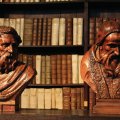Museum dedicated to the history of printing from the 15th to the 18th century, with collections and copies of the Gutenberg Bible
Dedicated to the history of printing from the 15th to the 18th century, this museum traces the life of the Plantin-Moretus family. After arriving in Antwerp as a bookbinder, the French humanist Christoffel Plantin became a printer in 1555 and set up his own business. His son-in-law, Jan Moretus, and his grandchildren expanded the family business in the 17th and 18th centuries. In 1876, Edouard Moretus sold the printing works and all its equipment to the City of Antwerp.
In addition to its superb period building and pretty interior garden, the museum showcases its splendid collections in 34 rooms. It boasts the world's only fully-equipped 16th-century printing office, a 17th-century press room, and 90 complete sets of lead type (including the only complete set of Garamont's original punches). You can also admire two of the world's oldest printing presses, still in working order! Also on display are old maps and maps of the world, as well as several paintings by Rubens, a family friend. Visitors can also wander through the publishing archives, as well as a library containing 25,000 volumes as precious as they are ancient.
The museum's masterpieces include two extremely rare and splendid copies of the Gutenberg Bible, including the only surviving copy of theIndex librorum prohibitorum printed before 1461. A real treasure trove. No wonder it's the first museum to be included on UNESCO's World Heritage List!
Did you know? This review was written by our professional authors.
Book the Best Activities with Get Your Guide
Members' reviews on PLANTIN-MORETUS MUSEUM
The ratings and reviews below reflect the subjective opinions of members and not the opinion of The Little Witty.
Find unique Stay Offers with our Partners





Copies of the anatomy atlas and geography atlas, which were printed in the printing house where the roots of fonts such as Times New Roman and Garamond, which are widely used today, emerged, should be reviewed before leaving the museum.
If you can find the room where the printing technique of old times is shown live to the visitors of the museum, it will not be a surprise if they give you a unique copy of the poem printed as a sample. If the text they use in printing has not changed yet, the poem is a very cheerful text. If I remember correctly, he was explaining the secret of happiness for a man. So it's not a very long poem.
If you are curious about printing, you can buy black aprons with the words “Labore et Constantia” written on them, worn by the printers in the museum, from the souvenir shop at the exit.
Be sure to take time to visit.